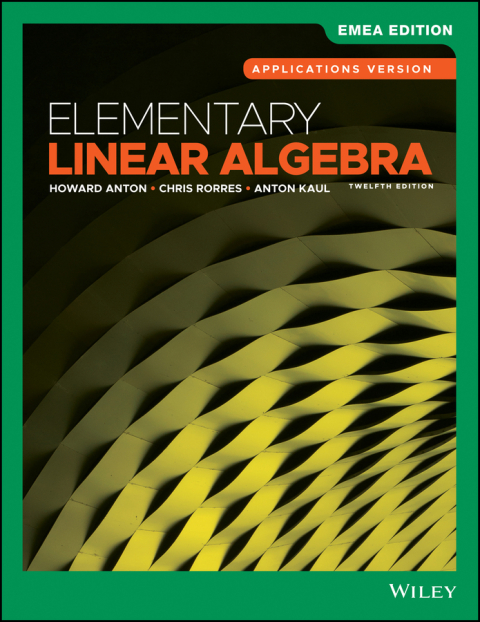Description
Efnisyfirlit
- Cover
- Table of Contents
- Applications and Historical Topics
- Title Page
- Copyright
- Dedication
- About the Authors
- Preface
- CHAPTER 1: Systems of Linear Equations and Matrices
- CHAPTER CONTENTS
- Introduction
- 1.1 Introduction to Systems of Linear Equations
- 1.2 Gaussian Elimination
- 1.3 Matrices and Matrix Operations
- 1.4 Inverses; Algebraic Properties of Matrices
- 1.5 Elementary Matrices and a Method for Finding A
- 1.6 More on Linear Systems and Invertible Matrices
- 1.7 Diagonal, Triangular, and Symmetric Matrices
- 1.8 Introduction to Linear Transformations
- 1.9 Compositions of Matrix Transformations
- 1.10 Applications of Linear Systems
- 1.11 Leontief Input‐Output Models
- Chapter 1 Supplementary Exercises
- CHAPTER 2: Determinants
- CHAPTER CONTENTS
- Introduction
- 2.1 Determinants by Cofactor Expansion
- 2.2 Evaluating Determinants by Row Reduction
- 2.3 Properties of Determinants; Cramer’s Rule
- Chapter 2 Supplementary Exercises
- CHAPTER 3: Euclidean Vector Spaces
- CHAPTER CONTENTS
- Introduction
- 3.1 Vectors in 2‐Space, 3‐Space, and n‐Space
- 3.2 Norm, Dot Product, and Distance in Rn
- 3.3 Orthogonality
- 3.4 The Geometry of Linear Systems
- 3.5 Cross Product
- Chapter 3 Supplementary Exercises
- CHAPTER 4: General Vector Spaces
- CHAPTER CONTENTS
- Introduction
- 4.1 Real Vector Spaces
- 4.2 Subspaces
- 4.3 Spanning Sets
- 4.4 Linear Independence
- 4.5 Coordinates and Basis
- 4.6 Dimension
- 4.7 Change of Basis
- 4.8 Row Space, Column Space, and Null Space
- 4.9 Rank, Nullity, and the Fundamental Matrix Spaces
- Chapter 4 Supplementary Exercises
- CHAPTER 5: Eigenvalues and Eigenvectors
- CHAPTER CONTENTS
- Introduction
- 5.1 Eigenvalues and Eigenvectors
- 5.2 Diagonalization
- 5.3 Complex Vector Spaces
- 5.4 Differential Equations
- 5.5 Dynamical Systems and Markov Chains
- Chapter 5 Supplementary Exercises
- CHAPTER 6: Inner Product Spaces
- CHAPTER CONTENTS
- Introduction
- 6.1 Inner Products
- 6.2 Angle and Orthogonality in Inner Product Spaces
- 6.3 Gram–Schmidt Process; QR‐Decomposition
- 6.4 Best Approximation; Least Squares
- 6.5 Mathematical Modeling Using Least Squares
- 6.6 Function Approximation; Fourier Series
- Chapter 6 Supplementary Exercises
- CHAPTER 7: Diagonalization and Quadratic Forms
- CHAPTER CONTENTS
- Introduction
- 7.1 Orthogonal Matrices
- 7.2 Orthogonal Diagonalization
- 7.3 Quadratic Forms
- 7.4 Optimization Using Quadratic Forms
- 7.5 Hermitian, Unitary, and Normal Matrices
- Chapter 7 Supplementary Exercises
- CHAPTER 8: General Linear Transformations
- CHAPTER CONTENTS
- Introduction
- 8.1 General Linear Transformations
- 8.2 Compositions and Inverse Transformations
- 8.3 Isomorphism
- 8.4 Matrices for General Linear Transformations
- 8.5 Similarity
- 8.6 Geometry of Matrix Operators
- Chapter 8 Supplementary Exercises
- CHAPTER 9: Numerical Methods
- CHAPTER CONTENTS
- Introduction
- 9.1 LU‐Decompositions
- 9.2 The Power Method
- 9.3 Comparison of Procedures for Solving Linear Systems
- 9.4 Singular Value Decomposition
- 9.5 Data Compression Using Singular Value Decomposition
- Chapter 9 Supplementary Exercises
- CHAPTER 10: Applications of Linear Algebra
- CHAPTER CONTENTS
- Introduction
- 10.1 Constructing Curves and Surfaces Through Specified Points
- 10.2 The Earliest Applications of Linear Algebra
- 10.3 Cubic Spline Interpolation
- 10.4 Markov Chains
- 10.5 Graph Theory
- 10.6 Games of Strategy
- 10.7 Forest Management
- 10.8 Computer Graphics
- 10.9 Equilibrium Temperature Distributions
- 10.10 Computed Tomography
- 10.11 Fractals
- 10.12 Chaos
- 10.13 Cryptography
- 10.14 Genetics
- 10.15 Age‐Specific Population Growth
- 10.16 Harvesting of Animal Populations
- 10.17 A Least Squares Model for Human Hearing
- 10.18 Warps and Morphs
- 10.19 Internet Search Engines
- 10.20 Facial Recognition
- Appendix A: Working with Proofs
- Appendix B: Complex Numbers
- Index
- End User License Agreement







Reviews
There are no reviews yet.